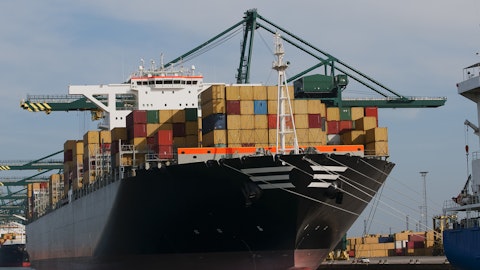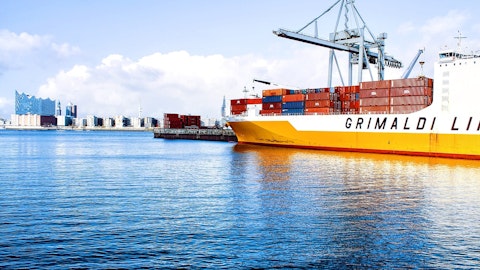Alexia Dodani: Yes. Good afternoon. Thank you for taking my questions. I had two to start first. And just on the implied Q4 EBITDA guide of around $1 billion. Obviously, the exit rate from Q3 has been quite strong. But, clearly, since the mid-September, we’ve seen the spot rate declined quite considerably. How should we think about the first half of Q4 versus the second half of Q4? Just to understand the exit rate as we go into the next year. Then secondly, on sort of your comments about sort of unit cost ability to change. When we look at 2023 and the current trajectory of spot rates, how can you protect profitability? What action are you able to take other than to basically reduce the capacity based on those — the delta you have between the upcoming vessels and the ones that are expiring. So, yes, those two please. Thank you.
Eli Glickman: Right. So starting with your first question, it is very true that the pace of the — maybe, should I say, the rate erosion of the — if we take the SCFI index, the decrease has accelerated over the past few weeks. So — and towards the second part of the third quarter, it’s been accentuated. So we have factored in, in our Q4 assumptions that leads to the guidance that we communicated today, a continuation of the trend to some extent. And — so we expect Q4 average freight rate to be less than what we delivered into Q3. In addition to that, from a volume perspective, we are also considering — and the two are being linked, in the way there is — on the one hand, the demand that is softening. And as a result, the company and also the — I think, largely, industry might take some actions in terms of additional blank space.
So we have also factored in a bit more of those in the fourth quarter, also explaining why the volume assumptions are a little bit lower than what we initially planned for. To your second question, looking at what it is that we can do on the — on our cost structure. We talked about the vessel cost. We’ve been, as you know, ZIM, has been transitioning from already over the past two years, transitioning from being very exposed to the short-term charter market, but gradually with all the contractors that we signed with other vessels owners. We have shifted towards being more exposed to long-term charter in the years to come. And we have experienced an increase in unit cost until this quarter and maybe into the next but in 2023 and beyond as we will take delivery of those newbuild capacity.
The cost per TEU will mechanically go down in terms of the vessel costs, the cost of sourcing capacity. In terms of variable cost, also with the congestion easing, we are going to incur less storage costs. The floor equipment is going to be improved as well. We are looking at how we can best optimize the usage of our fleet of containers. Today, we have close to 1 million TEUs million capacity of equipment. And it is very possible that we will deliver some of the older equipment as the flow of cargo eases into 2023. So we will be more efficient in operating of these containers.
Alexia Dodani: And can I just ask a follow-up on the first question. In terms of the kind of split between the evolution and if we look at how spot rates have accelerated, would it be fair to say the EBITDA skewed towards the first half of Q4, roughly two-third, one-third, if I just look at the kind of trajectory rate?
Eli Glickman: Alexia, I’m not so sure I understand your question. Are you talking about the three months into Q4, whether we expect a further reduction in November and then a stabilization in December?
Alexia Dodani: Yes, exactly, whether you expect most of the profitability in Q4 to come from October and November and later in December.
Eli Glickman: Today, we expect the rate to continue to go down. It depends also on the trade because we think that there are contracts that have been more exposed to the rate deterioration than others. To some extent, for example, the Atlantic is behaving better today. The US West Coast has been suffering much more than the other trade lanes. So we need to look at the mix of trade where we operate. We still take the conservative view that the rates will continue to go down. You see that the guidance in terms of rent is still $300 million. So we — obviously, we cannot be absolutely sure to what will be the prevailing rate of the remainder of the year. We know that what the rates will be in the weeks to come up until the end of the year. So what will affect also, our Q4 €“ our Q4performance, even if the boxes have not reached their final destination by the end of the year. That’s the accounting rules.
Alexia Dodani: Okay. Understood. Thank you.
Operator: Our next question is from Sathish Sivakumar from Citigroup. Please go ahead.
Sathish Sivakumar: Thanks again for the presentation. I’ve got two questions here. So firstly, on the — in your guidance, right, you did say that one of the reasons for the revisions and guidance is lower contract rates. If I understand, right, you got your contract rate exposure is mainly from transpacific, which normally resets in April, right? So, why does we are actually seeing lower contract rate versus, say, Q3 or versus your previous expectation? Any color on that? And also directionally, like how much it’s actually come down versus your previous expectation? And the second one is around the supply side flexibility on supply. You made it clear that, okay, you got about 60 vessels that are on charter that’s due for renewal versus 40 vessels you are taking in.
But that’s more like, say, in two years’ time where you get a better supply management there. But into next year, given the uncertainties and if potentially, further downturn in demand, what are the tools that you have in terms of like supply management as we go into H1 next year?





